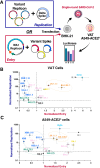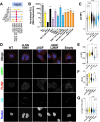Enhanced RNA replication and pathogenesis in recent SARS-CoV-2 variants harboring the L260F mutation in NSP6
- PMID: 40163530
- PMCID: PMC11981139
- DOI: 10.1371/journal.ppat.1013020
Enhanced RNA replication and pathogenesis in recent SARS-CoV-2 variants harboring the L260F mutation in NSP6
Abstract
The COVID-19 pandemic has been driven by SARS-CoV-2 variants with enhanced transmission and immune escape. Apart from extensive evolution in the Spike protein, non-Spike mutations are accumulating across the entire viral genome and their functional impact is not well understood. To address the contribution of these mutations, we reconstructed genomes of recent Omicron variants with disabled Spike expression (replicons) to systematically compare their RNA replication capabilities independently from Spike. We also used a single reference replicon and complemented it with various Omicron variant Spike proteins to quantify viral entry capabilities in single-round infection assays. Viral entry and RNA replication were negatively correlated, suggesting that as variants evolve reduced entry functions under growing immune pressure on Spike, RNA replication increases as a compensatory mechanism. We identified multiple mutations across the viral genome that enhanced viral RNA replication. NSP6 emerged as a hotspot with a distinct L260F mutation independently arising in the BQ.1.1 and XBB.1.16 variants. Using mutant and revertant NSP6 viral clones, the L260F mutation was validated to enhance viral replication in cells and increase pathogenesis in mice. Notably, this mutation reduced host lipid droplet content by NSP6. Collectively, a systematic analysis of RNA replication of recent Omicron variants defined NSP6's key role in viral RNA replication that provides insight into evolutionary trajectories of recent variants with possible therapeutic implications.
Copyright: © 2025 Taha et al. This is an open access article distributed under the terms of the Creative Commons Attribution License, which permits unrestricted use, distribution, and reproduction in any medium, provided the original author and source are credited.
Conflict of interest statement
I have read the journal's policy and the authors of this manuscript have the following competing interests: TYT and MO are inventors on a patent application filed by the Gladstone Institutes that covers the use of pGLUE to generate SARS-CoV-2 infectious clones and replicons. MO is a cofounder of DirectBio and on the SAB for Invisishield. The NJK Laboratory has received research support from Vir Biotechnology, F. Hoffmann-La Roche, and Rezo Therapeutics. NJK has a financially compensated consulting agreement with Maze Therapeutics. NJK is the President and is on the Board of Directors of Rezo Therapeutics, and he is a shareholder in Tenaya Therapeutics, Maze Therapeutics, Rezo Therapeutics, GEn1E Lifesciences, and Interline Therapeutics. All other authors declare no competing interests.
Figures




References
MeSH terms
Substances
Supplementary concepts
Grants and funding
LinkOut - more resources
Full Text Sources
Medical
Miscellaneous

